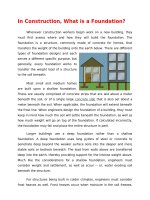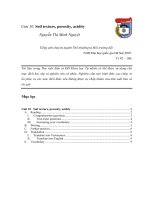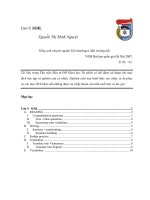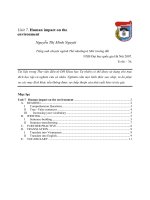tiếng anh chuyên ngành cầu đường: driven piles
Bạn đang xem bản rút gọn của tài liệu. Xem và tải ngay bản đầy đủ của tài liệu tại đây (62.34 KB, 2 trang )
When the upper soil structure is too weak to support a wind tower foundation, driven piles offer a
deep foundation solution.
Driven piles can be a cost-effective foundation
system for some wind tower sites underlain by loose or
soft soils, or mine spoils, which can provide insufficient
bearing capacity and excessive settlement. The piles are
driven around the perimeter of the tower foundation to
resist the overturning moment by means of
compression and tension loads. Driven piles may be
slightly battered outward to resist lateral loads. Since
driven piles do not require predrilling, they can be
driven into a contaminated soil profile without
producing spoil that can require costly removal.
Driven pile types include steel H-piles, pipe piles with concrete fill, precast concrete
piles, mandrel driven shell piles, and combinations of the aforementioned. The type is chosen
depending upon design capacity, drivability, and material costs. Typical pile size ranges from 12
to 30-inch equivalent diameter and typical design capacity ranges from 50 to 300 tons. The piles
are designed for both the required structural capacity and stresses incurred during driving. Steel
piles can be provided with epoxy coating when installed in corrosive soil environments.
Piles are typically driven with crane-mounted fixed or swinging leads and an impact pile
hammer or vibrator hammer. In general, crawler cranes with capacities from 50 to 150 tons are
used. Impact pile hammer types include air, diesel, hydraulic, and drop (gravity), and they
provide rated energy from 25,000 to 200,000 ft lbs. The drive head contains a cushion material
that is placed between the hammer and pile to prevent damage to the hammer and pile. The
drive head also keeps the pile centered under the hammer. Vibratory hammers can also be used
to drive piles. Vibrations from any small- to medium-size hammer will generally not harm
adjacent structures in good condition. This concern is typically not an issue with wind tower
foundations since wind farms tend to be remote or not adjacent to existing structures.
Pile foundation design is based upon an understanding of the hammer-pile-soil
interaction during installation and the superstructure pile-soil interaction after construction.
Piles must be installed to provide the required foundation behavior with consideration of the
feasibility of pile installation controlled by an understanding of the hammer-pile-soil system.
Consideration of pile installation in general can be characterized by the pile hammer as a driving
energy source, the pile as a transmitting element, and the soil conditions as a resistant force to
pile penetration. The pile driving behavior can be simulated by using wave propagation theory
as an analytical tool. The analysis can predict the required driving resistance for a specified
design pile capacity and a selected hammer-pile-soil system.
Quality control for driven piles includes logging the number of hammer blows per foot of
depth. By monitoring the resistance to driving, the pile hammer acts as a measuring tool as well
as an installation tool. Full-scale compression pile load testing and/or tension testing is typically
performed on one or more production piles to verify the pile driving criteria. If a vibratory
hammer is used to drive the pile, verification of the final seating criteria can be accomplished
with an impact hammer. Vibratory hammers can be
used for final driving criteria with field verification of
penetration rate and horsepower, supported by pile
load testing. Additional dynamic testing can be done to
verify the performance of the pile driving in lieu of
additional pile load testing. Two strain transducers and
two piezoresistive accelerometers are attached three
feet below the top of the pile to determine transferable
energy, maximum pile stresses, and to estimate pile
capacity during pile driving. Software can be used to
further evaluate static pile capacity including relative
load distribution along the pile length and toe at a specified pile depth.
Driven pile foundations have been used to support many types of onshore and offshore
structures over the past 100 years, including recent wind tower foundations. Driven piles will
continue to be an economical solution for future wind turbine foundations.









